
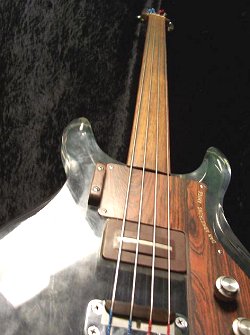
|
Seen more towards the end days of production, Dan had said that "approximately 150 or more fretless basses were
produced." This would be typical, not only of Dan, but also of Ampeg - who produced many fretless versions of
various basses over the years prior to the Dan Armstrong line. It must have been one of the rare occassions where Dan
Armstrong & Ampeg actually saw 'eye to eye' on things.
"Dan absolutely loved playing fretless basses and it was no big surprise to me when I learned that Ampeg started
producing them." say's Dan's former employee Steve Kubica - for he knew that Dan played the stand up bass back
in his high school days.
As seen at left, because these basses were produced toward the latter days of production it's fairly common for most (though
by no means all) of these basses to sport a pickup with the additional resin on top.
|
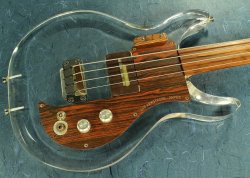
|
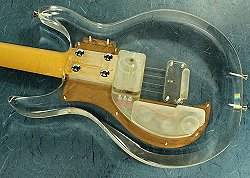
|
Seen at left however, this fretless bass was equipped with an older style pickup - without the additional resin around the pole piece - thus the chipping
and flaking away of the resin and exposing the white coil bobbin underneath. Because the basses were made at a latter time they all sported a selector switch
somewhat like the guitar model. At right, and again being a latter made bass, these instruments were wired as per Ampeg's Product Bulletin #17. Back at left,
notice the added washer on the output jack.
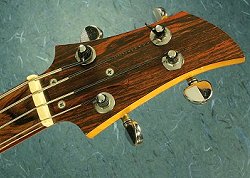
|
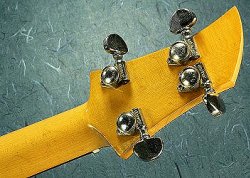
|
Above left and right, a beautiful rosewood fingerboard leads to a nicely matched headstock which is adorned with Grover tuners.
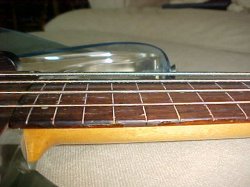
|
As seen at left, a bass with the low serial number of D150A looking somewhat out of time as it's showing a fretless
fingerboard. Even more odd is that in the enlarged view the standard 3mm dot position markers can be seen.
Most unusual is that the inlays span the entire width of the fingerboard. Given such unusual inlays on
such an early instrument seems to suggest that custom work was done where most likely an owner had the frets removed
and filled in the open fret slots with some type of inlay material.
|
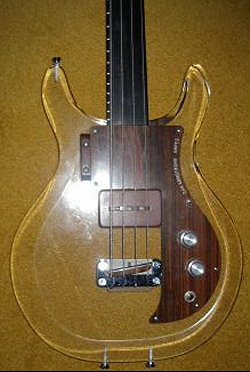
|
This Dan Armstrong fretless bass has inlays only partially seen on the low 'E' side of the fingerboard, allowing the
player to see just enough which was crucial to any player not accustomed to playing a fretless bass instrument.
Later in his career Dan would expand on the design, choosing to utilize position markers in approximately this
same location on the fingerboards of all his 'London' series guitar and basses.
This particular bass has all the signs of an older bass in that it lacks the pickup selector switch, yet it is also
equipped with a newer combination bridge/tailpiece that is sandblasted, as well as a later style bridge with a fret
lying across it. As such it is hard to speculate as to whether it is a newer model with an older scratchplate, or an
older model with newer hardware and neck.
Serial numbers and potentiometer codes would be the only way to date such an instrument, and even they can be
misleading since all parts are interchangeable, and were available through Ampeg for some time.
|
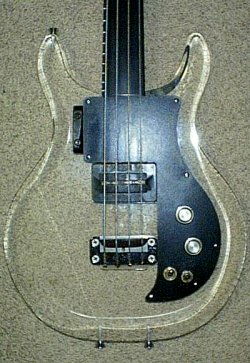
|
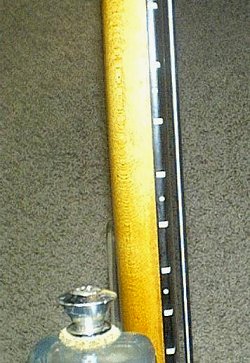
|
As seen above left, a later model fretless bass with ebony fingerboard, scratchplate and thumb rest that appears to have
all the period correct hardware, with perhaps one exception. I'm not certain, but it appears that the faux-wood scratchplate
may be a replacement. For starters the usual white colored etched-in lettering that spells out the usual Dan Armstrong · Ampeg
name is missing - there does not appear to be a trace, or a faint hint that it ever existed.
Second, is the look. While the overall shape of the scratchplate is very well done, it nevertheless seems to show a tell-tale
inconsistency. For if you look at the mounting screw that's positioned straight up from the volume control (in this photo),
you will notice a minor indentation in the scratchplate that just looks wrong, like some of the screw holes were close, but not
dead on. Coupled together this would all seem to suggest that the plate is a non-factory replacement. A very well made one, but
I do not believe it's original. Notice the inlay work on the neck only partially filled in, not extending the full width of the fingerboard.
At upper right, the aforementioned inlay work as seen from the side, or stated another way, as seen from a players
perspective. Notice the fairly low action on this bass. Virtually all Dan Armstrong basses are capable
of string action that is even lower than what is shown here. On such an instrument, with no frets, one
could, if so inclined, lower the action to the point that would rival even the best of six string guitars,
let alone a bass.
Above left, a faux-wood ebony scratchplate that looks correct, in that it features the white etched-in letters that spell out
Dan Armstrong · Ampeg - and what is missing from the model shown above. At right, basses manufactured with
ebony fingerboards with matching scratchplates and thumb rests also sport matching faux-wood veneers on the headstock, as well as
truss rod covers.
In my first interview with Dan, back in 1999 I recall that Dan was almost chuckling as he told me the story about one
of his clear acrylic basses saying "one year on my birthday I was surprised with the gift of a Dan Armstrong
fretless bass that was specially made just for me. Someone found out that I loved fretless ebony fingerboards and that's
what this bass had. I was in the process of moving so I left the bass with a friend. A few months after my move I
checked back in with my friend only to find out that he pawned it, or sold it. The next time I saw that bass it was
being played by none other than bassist Jack Bruce."
continue
menu
Names and images are TMand © Dan Armstrong / Ampeg. All rights reserved.
All other names and images are TMand © of their respective owners. All rights reserved.
|
| |

